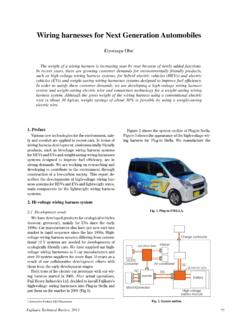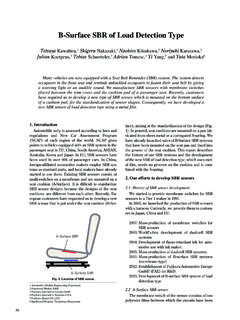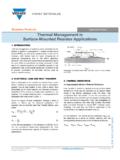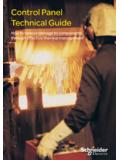Transcription of Piezo Fan for Thermal Management of Electronics
1 Fujikura Technical Review, 201039 Piezo Fan for Thermal Management of ElectronicsKuo Hao Tseng,1 Masataka Mochizuki,1 Koichi Mashiko,1 Tomoyuki Kosakabe,1 Eiji Takenaka,2 Kazuhiro Yamamoto,3 and Ryo Kikutake3In order to satisfy the demand for light-weight, low power consumption, and compact-sized personal computers, portable Electronics , LED applied products and audio Electronics , we have developed a ' Piezo fan' that works on a different principle from that of motor fans. By using the finite-element method for design support, the demands for long life and compact size were achieved. Also, on the basis of the supposed application, the cooling effects and the cooling possibilities of Piezo fans were confirmed by applying them to the heat sources of personal computers, portable Electronics , and LED applications.
2 1. IntroductionMost people imagine a heat sink and a fan on a CPU when Thermal Management of Electronics is men-tioned. However, in this field, people are looking for improvements or replacements of current fans be-cause there are still many issues such as fan noise, power consumption, size, and the life issue due to wear of the bearing. One important issue of axial fans is that there is no air flow around the center of the rotation center of the fan, and the air flow is vortex flow. Since heat sinks usually have a linear flow channel, the air flow cannot cool the heat sink effectively. Piezo fan has been researched and developed be-cause it has features of low noise and low power con-sumption1). Lately, more researches have been con-ducted because people think that Piezo fan can fulfill the demands of Electronics cooling module such as light weight, low noise and compact size2) 3).
3 In this re-search, we first realized the basic demand for the life and robust issue. Then, according to the features in-cluding air flow and shapes, we designed and tested compact cooling modules according to the demands of mobile Electronics with multiple heat sources, low cost PC and LED modules. 2. Operation principle and characteristics of Piezo Operation principle of Piezo fanThe electric field induced strain of piezoelectric ele-ment is called inverse piezoelectric effect . Normally, this strain itself is too small to use. In order to obtain more displacement, a metal or a plastic sheet (blade) is attached on the piezoelectric element, so that it can bend as a bimetallic strip. As shown in Fig. 1(a), this structure bends upward while applying a positive volt-age and downward while applying a negative voltage.
4 Although the displacement is enough in some fields, it is still not large enough to generate air flow for cool-ing. By elongating the blade and actuating the struc-ture at its resonant frequency as shown in Fig. 1(b), the free end of the blade resonates with large displace-ment and thus the requisite air flow becomes avail-able. Characteristics of Piezo fanFigure 2 shows the relation between the actuation 1 Thermal Technology Division2 Plant & Production Engineering Division3 Environment and Energy LaboratoryFig. 1. Operation principle of Piezo fan.(a)(b)PiezoPiezoBladeBladeMovement of Piezo fanAirflowdirectionFig. 2. Characteristics of Piezo (Hz)140 Vpp110 Vpp85 Vppvibration amplitude (mm)01051520255859606162636440frequency and the amplitude of the Piezo fan tip while applying sine voltage to it.
5 Strain of piezoelectric ele-ment is almost proportional to the applied electric field, thus increase in the voltage (Vpp) increases the strain energy and Piezo fan amplitude. The result in Fig. 2 also indicates that the amplitude has a maximum value at some specific frequency. This is because pi-ezo fans use resonance for larger amplitude and more air flow. Low driving voltage Piezo fanDue to many reasons such as insulation, cost and safety issues, high voltage is not preferred in electron-ics. However, large air flow comes from large Piezo fan amplitude, and the amplitude comes from high elec-tric field. Here, we decreased the thickness of Piezo -electric element to increase the electric field at the same voltage at first.
6 Then, we laminated the thin piezoelectric elements to increase the generated force and attached the laminated elements to the blade. Ta-ble shows the performance of two Piezo fans with the same geometric configuration and indicates the effec-tiveness of decreasing the driving Long life and robust Piezo fanFigure 1(b) shows a typical Piezo fan comprising a piezoelectric element and a blade made from thin sheet. However, this structure works but has prob-lems in life test because the inertial force of the blade tip applies large moment to the piezoelectric element. Especially, large stress appears around the free end of the piezoelectric element. As a result, the blade gets detached from the piezoelectric element in a long-term test. Moreover, the inertial force becomes very large when foreign objects come in contact with the moving Piezo fan and, thus, detachment occurs frequently in this condition.
7 Also, the adhesive connecting the Piezo and the blade tends to lose its adhesion force. Thus, the detachment occurs especially frequently in high-temperature environment. Figure 3 shows our solution. Figure 3(a) shows the traditional structure of Piezo fan and indicates the posi-tion where stress concentrates. We relaxed the con-centrated stress by putting a supporting block as shown in Fig. 3(b).Figure 4 shows the result of the FEM results by us-ing ANSYS . For convenience of explanation, the Table. Comparision of single-and multilayer Piezo voltageResonant frequencyVibration amplitudeConsumption power Single-layer Piezo fan65 Vpp46 Hz26 mm7 mWMultilayer Piezo fan(10 layers) Hz25 mm6 mWFig. 4. Stress analysis of a Piezo (a) Without a supporting block(b) Using a supporting blockFig.
8 3. The structure of the long-life Piezo fan.(a)(b)Stress concentrationPiezoSupporting blockPanel 1. Abbreviations, Acronyms, and The materials with the ability to generate electric field in response applied StrainLED Light-Emitting DiodeCPU Central Processing UnitPC Personal ComputerFEM Finite Element MethoddBA A sound pressure unit simulating the human-ear responseFujikura Technical Review, 201041piezoelectric element is set to be invisible and its con-tour is marked by dotted lines. Figure 4(a) and (b) shows the Von Mises stress while the blade has the maximum displacement at its first resonance. The structure in Fig. 4(b) uses the same structure shown in Fig. 3(b). It is clear that large stress exists around the free end of the piezoelectric element and the stress is supported by adhesive only.
9 It is considered that the blade detaches from piezoelectric element when the adhesive force decreases or when external force causes the concentrated force to increase. Figure 4(b) using the structure with a supporting block shows that the concentrated stress relaxes a lot, but the displace-ment is almost the same. Also, although not shown in the figure, the maximum displacement and stress of the piezoelectric element itself also decreases in the structure with a supporting block. This means that this structure can also help to prevent the crack gen-eration on the piezoelectric 5 shows the test results of Piezo fans under 100 C environment. The Piezo fans had 60 Hz reso-nant frequency at first. However, as shown in the fig-ure, the resonant frequency of the Piezo fans without supporting blocks changed in this test.
10 At the same time, the displacement also decreased while actuating these Piezo fans by the resonant frequency. On the contrary, those Piezo fans with supporting blocks kept the performance even when the adhesive force de-creased at high temperature. In another test, Piezo fans were set in a high-temperature and high-humidity environment (60 C,65%). In this test also, Piezo fans retained the performance after more than 109 times the vibration (30 mm amplitude, 60 Hz).4. Electronics cooling of Piezo Portable Electronics cooling of Piezo fansOne characteristic of portable Electronics cooling is that multiple cooling objectives exist, but heat flow of each heat source is much lower than that in PC. The point is that the Thermal Management must be based on low consumption power and low noise at close range.












